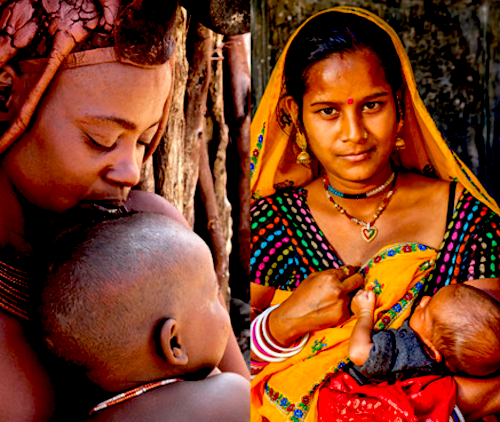|
|
Developmental Biology - Fetal Viral Immunity
Fewer Dangerous Human Viruses in Breastfed Babies
Breastmilk strongly helps in the accumulation of good viruses that protect against more dangerous disease causing viruses...
Even small amounts of breastmilk strongly influences the accumulation of virus populations in the infant gut, providing protection against potentially pathogenic types. This observation is made by researchers who examined hundreds of babies in a study from the Perelman School of Medicine at the University of Pennsylvania.
These findings expand upon prior research suggesting that breastfeeding plays a key role in the interaction between babies and the microbial environment they are born into. This latest research could influence strategies for preventing early gastrointestinal disorders, and encouraging mothers to feed babies breastmilk even if supplementing with formula.
Findings are published in the journal: Nature.
Penn research measured the numbers and types of viruses in each baby's first stool - meconium - and subsequent stools of those same infants when compared to newborns in the United States and Botswana. Researchers used advanced gene sequencing to identify any viral contamination. Immediately following delivery, babies had little or no viral colonization. But after one month of life, populations of viruses and bacteria were well developed with numbers of viruses reaching a billion per gram of gut contents.
Most of the first wave of viruses turn out to be predators that grow in the first bacteria to colonize the infant gut. Later, at four months, viruses that can replicate in human cells - and potentially make humans sick - were more prominently found in baby stools.
A strong protective effect was seen from breastfeeding, which suppressed accumulation of potentially pathogenic viruses. Similar results were seen in infants from both Botswana and the USA.
Another conclusion is that breastmilk could be protective even if sometimes supplemented with formula, compared to a formula-only diet.
"These findings can help us better understand why some babies get sick and develop life-threatening infections in their first months of life," explains senior author Frederic Bushman PhD, chair of the department of Microbiology.
"Location of the mom and baby seems to play a role, probably due to the kind and number of microorganisms babies are exposed to through environment. Nevertheless, Botswana-born babies still seemed to benefit from breastfeeding, whether exclusively breastfed or when supplementing with formula."
Guanxiang Liang PhD, a postdoctoral researcher in the department at Microbiology and first author.
In the future, Bushman and Liang want to look at varying ages to see (1) how development of the virome - the average virus population in the gut - influences a child's growth, and (2) how virome colonization varies in infants around the world, and (3) how virome colonization influences preterm birth.
Abstract
The gut of healthy human neonates is usually devoid of viruses at birth, but quickly becomes colonized, which—in some cases—leads to gastrointestinal disorders1,2,3,4. Here we show that the assembly of the viral community in neonates takes place in distinct steps. Fluorescent staining of virus-like particles purified from infant meconium or early stool samples shows few or no particles, but by one month of life particle numbers increase to 109 per gram, and these numbers seem to persist throughout life5,6,7. We investigated the origin of these viral populations using shotgun metagenomic sequencing of virus-enriched preparations and whole microbial communities, followed by targeted microbiological analyses. Results indicate that, early after birth, pioneer bacteria colonize the infant gut and by one month prophages induced from these bacteria provide the predominant population of virus-like particles. By four months of life, identifiable viruses that replicate in human cells become more prominent. Multiple human viruses were more abundant in stool samples from babies who were exclusively fed on formula milk compared with those fed partially or fully on breast milk, paralleling reports that breast milk can be protective against viral infections8,9,10. Bacteriophage populations also differed depending on whether or not the infant was breastfed. We show that the colonization of the infant gut is stepwise, first mainly by temperate bacteriophages induced from pioneer bacteria, and later by viruses that replicate in human cells; this second phase is modulated by breastfeeding.
Authors
Guanxiang Liang, Chunyu Zhao, Huanjia Zhang, Lisa Mattei, Scott Sherrill-Mix, Kyle Bittinger, Lyanna R. Kessler, Gary D. Wu, Robert N. Baldassano, Patricia DeRusso, Eileen Ford, Michal A. Elovitz, Matthew S. Kelly, Mohamed Z. Patel, Tiny Mazhani, Jeffrey S. Gerber, Andrea Kelly, Babette S. Zemel and Frederic D. Bushman.
Acknowledgements
The research was done in collaboration with the division of Gastroenterology, Hepatology, and Nutrition at Children's Hospital of Philadelphia and the department of Paediatric and Adolescent Health, Faculty of Medicine of the University of Botswana.
Funding support for the study comes from the National Institutes of Health (R61-HL137063, R01-HL113252, R01DK107565, UL1TR000003, UL1TR001878, K23 AI135090), the Penn Center for AIDS Research (P30 AI 045008), the PennCHOP Microbiome Program, the Commonwealth Universal Research Enhancement (C.U.R.E) program (SAP # 4100068710), the American Beverage Foundation for a Healthy America, and the Duke Center for AIDS Research (5P30 AI064518)
Return to top of page.
| |
|
Apr 21 2020 Fetal Timeline Maternal Timeline News
 At four months of age, infant stools suggest one benefit of breastfeeding is cultivation of GOOD viruses that overwhelm lethal viruses. CREDIT National Public Radio.
|



